Modification of Electrospun CeO2 Nanofibers with CuCrO2 Particles Applied to Hydrogen Harvest from Steam Reforming of Methanol
Abstract
:1. Introduction
2. Materials and Methods
2.1. Instrumentation
2.2. Preparation of CeO2 Nanofibers
2.3. Surface Modification of CeO2 Nanofibers
2.4. Preparation of CeO2 Nanofibers Decorated with CuCrO2 Nanoparticles (CeO2-CuCrO2)
2.5. Steam Reforming of Methanol Process over Electrospun CeO2-CuCrO2 Nanofibers Catalyst
3. Results and Discussion
3.1. XRD Analysis
3.2. FESEM Analysis
3.3. TEM and STEM-EDS Analysis
3.4. TGA Analysis
3.5. Specific Surface Area Analysis
3.6. Steam Reforming of Methanol Performance
4. Conclusions
Author Contributions
Funding
Institutional Review Board Statement
Informed Consent Statement
Data Availability Statement
Acknowledgments
Conflicts of Interest
References
- Yu, C.L.; Sakthinathan, S.; Hwang, B.Y.; Lin, S.Y.; Chiu, T.W.; Yu, B.S.; Fan, Y.J.; Chuang, C. CuFeO2–CeO2 Nanopowder Catalyst Prepared by Self-Combustion Glycine Nitrate Process and Applied for Hydrogen Production from Methanol Steam Reforming. Int. J. Hydrogen Energy 2020, 45, 15752–15762. [Google Scholar] [CrossRef]
- Huang, R.J.; Sakthinathan, S.; Chiu, T.W.; Dong, C. Hydrothermal Synthesis of High Surface Area CuCrO2 for H2 production by Methanol Steam Reforming. RSC Adv. 2021, 11, 12607–12613. [Google Scholar] [CrossRef] [PubMed]
- Yu, C.L.; Sakthinathan, S.; Chen, S.Y.; Yu, B.S.; Chiu, T.W.; Dong, C. Hydrogen Generation by Methanol Steam Reforming Process by Delafossite-Type CuYO2 Nanopowder Catalyst. Microporous Mesoporous Mater. 2021, 324, 111305. [Google Scholar] [CrossRef]
- Chiu, T.W.; Hong, R.T.; Yu, B.S.; Huang, Y.H.; Kameoka, S.; Tsai, A.P. Improving Steam-Reforming Performance by Nanopowdering CuCrO2. Int. J. Hydrogen Energy 2014, 39, 14222–14226. [Google Scholar] [CrossRef]
- Abbasi, M.; Farniaei, M.; Rahimpour, M.R.; Shariati, A. Enhancement of Hydrogen Production and Carbon Dioxide Capturing in a Novel Methane Steam Reformer Coupled with Chemical Looping Combustion and Assisted by Hydrogen Perm-Selective Membranes. Energy Fuels 2013, 27, 5359–5372. [Google Scholar] [CrossRef]
- Wiese, W.; Emonts, B.; Peters, R. Methanol Steam Reforming in a Fuel Cell Drive System. J. Power Sources 1999, 84, 187–193. [Google Scholar] [CrossRef]
- Palo, D.R.; Dagle, R.A.; Holladay, J.D. Methanol Steam Reforming for Hydrogen Production. Chem. Rev. 2007, 107, 3992–4021. [Google Scholar] [CrossRef]
- Itoh, N.; Kaneko, Y.; Igarashi, A. Efficient Hydrogen Production via Methanol Steam Reforming by Preventing Back-Permeation of Hydrogen in a Palladium Membrane Reactor. Ind. Eng. Chem. Res. 2002, 41, 4702–4706. [Google Scholar] [CrossRef]
- Pajaie, H.S. Hydrogen Production from Methanol Steam Reforming over Cu/ZnO/Al2O3/CeO2/ZrO2 Nanocatalyst in an Adiabatic Fixed-Bed Reactor. Iran. J. Energy Environ. 2012, 3, 307–313. [Google Scholar] [CrossRef]
- Papavasiliou, J.; Avgouropoulos, G.; Ioannides, T. Production of Hydrogen via Combined Steam Reforming of Methanol over CuO-CeO2 Catalysts. Catal. Commun. 2004, 5, 231–235. [Google Scholar] [CrossRef]
- Chen, W.H.; Lin, B.J. Effect of Microwave Double Absorption on Hydrogen Generation from Methanol Steam Reforming. Int. J. Hydrogen Energy 2010, 35, 1987–1997. [Google Scholar] [CrossRef]
- Agrell, J.; Birgersson, H.; Boutonnet, M. Steam Reforming of Methanol over a Cu/ZnO/Al2O3 Catalyst: A Kinetic Analysis and Strategies for Suppression of CO Formation. J. Power Sources 2002, 106, 249–257. [Google Scholar] [CrossRef]
- Kameoka, S.; Tanabe, T.; Tsai, A.P. Self-Assembled Porous Nano-Composite with High Catalytic Performance by Reduction of Tetragonal Spinel CuFe2O4. Appl. Catal. A Gen. 2010, 375, 163–171. [Google Scholar] [CrossRef]
- Christopher, J.; Swamy, C.S. Catalytic Activity and XPS Investigation of Dalofossite Oxides, CuMO2 (M=Al, Cr or Fe). J. Mater. Sci. 1992, 27, 1353–1356. [Google Scholar] [CrossRef]
- Saadi, S.; Bouguelia, A.; Trari, M. Photocatalytic Hydrogen Evolution over CuCrO2. Sol. Energy 2006, 80, 272–280. [Google Scholar] [CrossRef]
- Shen, J.P.; Song, C. Influence of Preparation Method on Performance of Cu/Zn-Based Catalysts for Low-Temperature Steam Reforming and Oxidative Steam Reforming of Methanol for H2 Production for Fuel Cells. Catal. Today 2002, 77, 89–98. [Google Scholar] [CrossRef]
- Abrokwah, R.Y.; Deshmane, V.G.; Owen, S.L.; Kuila, D. Cu-Ni Nanocatalysts in Mesoporous MCM-41 and TiO2 to Produce Hydrogen for Fuel Cells via Steam Reforming Reactions. Adv. Mater. Res. 2015, 1096, 161–168. [Google Scholar] [CrossRef] [Green Version]
- Navarro, R.M.; Peña, M.A.; Fierro, J.L.G. Production of Hydrogen by Partial Oxidation of Methanol over a Cu/ZnO/Al2O3 Catalyst: Influence of the Initial State of the Catalyst on the Start-up Behaviour of the Reformer. J. Catal. 2002, 212, 112–118. [Google Scholar] [CrossRef]
- Lindström, B.; Pettersson, L.J.; Menon, G. Activity and Characterization of Cu/Zn, Cu/Cr and Cu/Zr on γ-Alumina for Methanol Reforming for Fuel Cell Vehicles. Appl. Catal. A Gen. 2002, 234, 111–125. [Google Scholar] [CrossRef]
- Shokrani, R.; Haghighi, M.; Ajamein, H.; Abdollahifar, M. Hybrid Sonochemic Urea-Nitrate Combustion Preparation of CuO/ZnO/Al2O3 Nanocatalyst Used in Fuel Cell-Grade Hydrogen Production from Methanol: Effect of Sonication and Fuel/Nitrate Ratio. Part. Sci. Technol. 2018, 36, 217–225. [Google Scholar] [CrossRef]
- Basile, A.; Parmaliana, A.; Tosti, S.; Iulianelli, A.; Gallucci, F.; Espro, C.; Spooren, J. Hydrogen Production by Methanol Steam Reforming Carried out in Membrane Reactor on Cu/Zn/Mg-Based Catalyst. Catal. Today 2008, 137, 17–22. [Google Scholar] [CrossRef]
- Huang, Y.H.; Wang, S.F.; Tsai, A.P.; Kameoka, S. Reduction Behaviors and Catalytic Properties for Methanol Steam Reforming of Cu-based Spinel Compounds CuX2O4 (X=Fe, Mn, Al, La). Ceram. Int. 2014, 40, 4541–4551. [Google Scholar] [CrossRef]
- Bichon, P.; Asheim, M.; Sperle, A.J.T.; Fathi, M.; Holmen, A.; Blekkan, E.A. Hydrogen from Methanol Steam-Reforming over Cu-based Catalysts with and without Pd Promotion. Int. J. Hydrog. Energy 2007, 32, 1799–1805. [Google Scholar] [CrossRef]
- Kameoka, S.; Okada, M.; Tsai, A.P. Preparation of a Novel Copper Catalyst in Terms of the Immiscible Interaction between Copper and Chromium. Catal. Lett. 2008, 120, 252–256. [Google Scholar] [CrossRef]
- Sato, S.; Takahashi, R.; Sodesawa, T.; Yuma, K.I.; Obata, Y. Distinction between Surface and Bulk Oxidation of Cu through N2O Decomposition. J. Catal. 2000, 196, 195–199. [Google Scholar] [CrossRef]
- Hwang, B.Y.; Sakthinathan, S.; Chiu, T.W. Production of Hydrogen from Steam Reforming of Methanol Carried out by Self-Combusted CuCr1-xFexO2 (x=0–1) Nanopowders Catalyst. Int. J. Hydrog. Energy 2019, 44, 2848–2856. [Google Scholar] [CrossRef]
- Amrute, A.P.; Larrazábal, G.O.; Mondelli, C.; Pérez-Ramírez, J. CuCrO2 delafossite: A Stable Copper Catalyst for Chlorine Production. Angew. Chem. Int. Ed. 2013, 52, 9772–9775. [Google Scholar] [CrossRef]
- Ketir, W.; Bouguelia, A.; Trari, M. NO3- Removal with a New Delafossite CuCrO2 Photocatalyst. Desalination 2009, 244, 144–152. [Google Scholar] [CrossRef]
- Singh, S. Cerium Oxide Based Nanozymes: Redox Phenomenon at Biointerfaces. Biointerphases 2016, 11, 04B202. [Google Scholar] [CrossRef] [Green Version]
- Hornés, A.; Hungría, A.B.; Bera, P.; López Cámara, A.; Fernández-García, M.; Martínez-Arias, A.; Barrio, L.; Estrella, M.; Zhou, G.; Fonseca, J.J.; et al. Inverse CeO2/CuO Catalyst as an Alternative to Classical Direct Configurations for Preferential Oxidation of CO in Hydrogen-Rich Stream. J. Am. Chem. Soc. 2010, 132, 34–35. [Google Scholar] [CrossRef]
- Li, Y.; Cai, Y.; Xing, X.; Chen, N.; Deng, D.; Wang, Y. Catalytic Activity for CO Oxidation of Cu-CeO2 Composite Nanoparticles Synthesized by a Hydrothermal Method. Anal. Methods 2015, 7, 3238–3245. [Google Scholar] [CrossRef]
- Tucker, N.; Stanger, J.J.; Staiger, M.P.; Razzaq, H.; Hofman, K. The History of the Science and Technology of Electrospinning from 1600 to 1995. J. Eng. Fibers Fabr. 2012, 7, 63–73. [Google Scholar] [CrossRef] [Green Version]
- Thavasi, V.; Singh, G.; Ramakrishna, S. Electrospun Nanofibers in Energy and Environmental Applications. Energy Environ. Sci. 2008, 1, 205–221. [Google Scholar] [CrossRef]
- Chao, T.C.; Chiu, T.W.; Fu, Y. Fabrication and Characteristic of Delafossite-Type CuFeO2 Nanofibers by Electrospinning Method. Ceram. Int. 2018, 44, S80–S83. [Google Scholar] [CrossRef]
- Huang, X.; Ma, L.; Wainwright, M.S. The influence of Cr, Zn and Co additives on the performance of skeletal copper catalysts for methanol synthesis and related reactions. Appl. Catal. A Gen. 2004, 257, 235–243. [Google Scholar] [CrossRef]

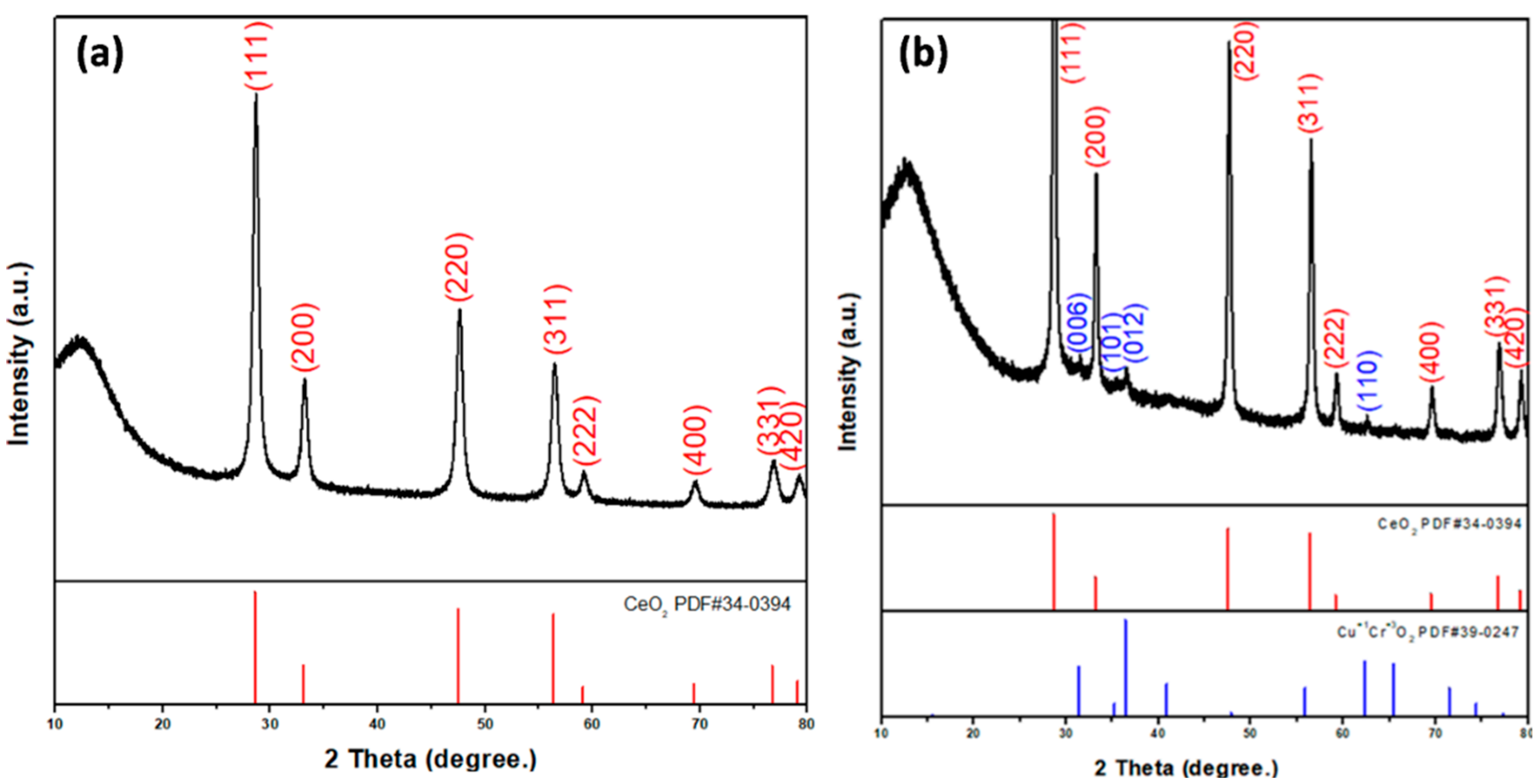
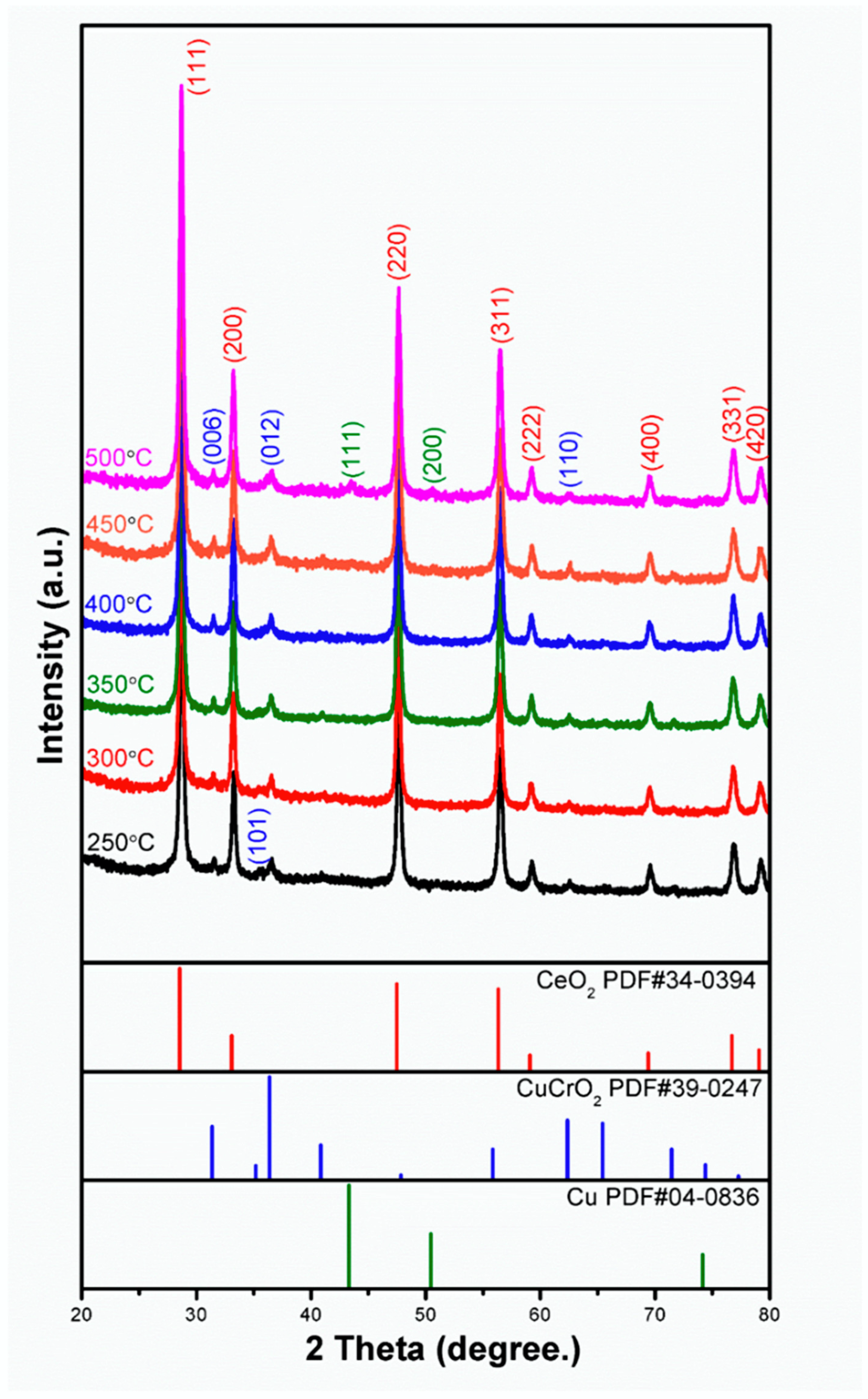
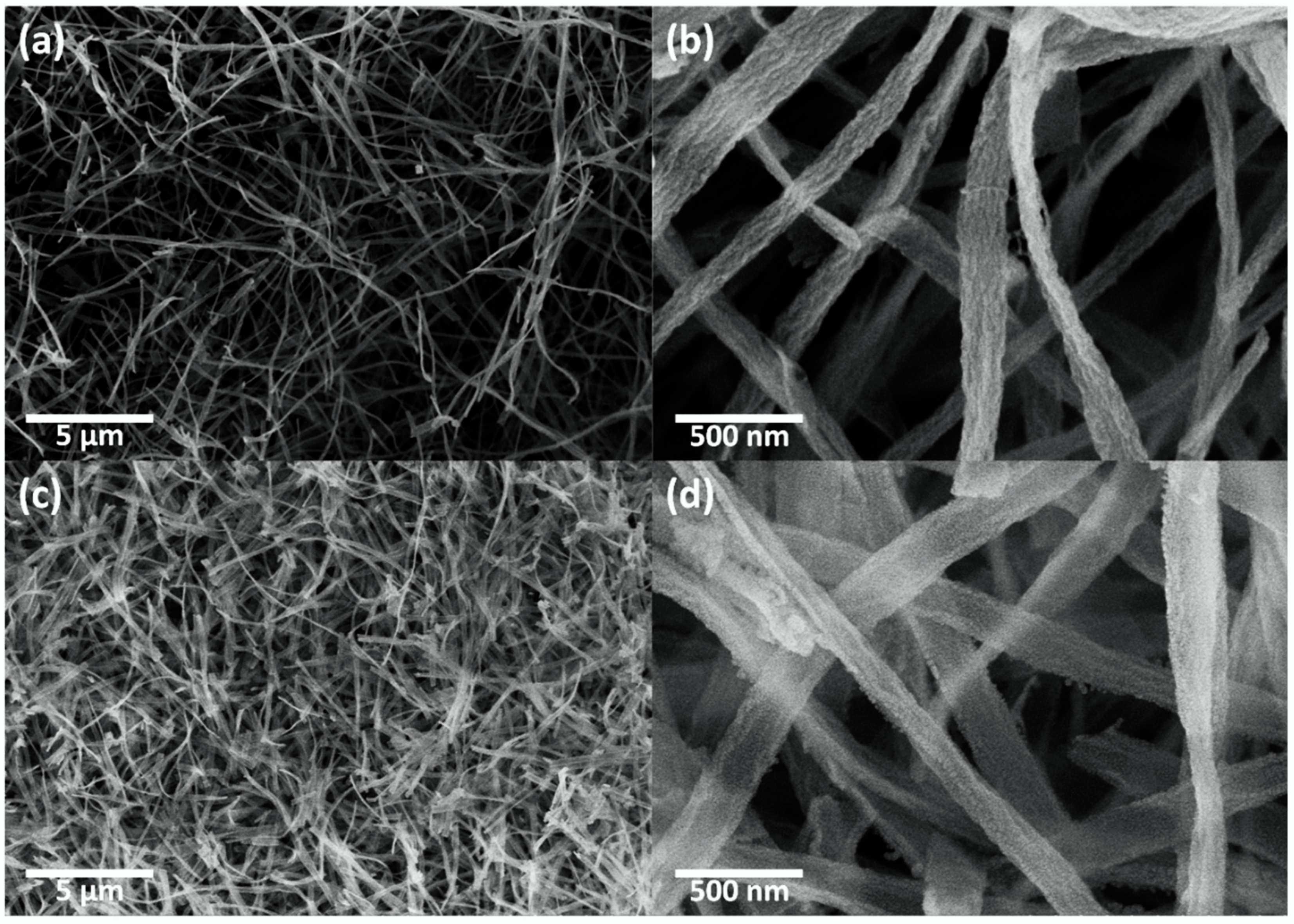
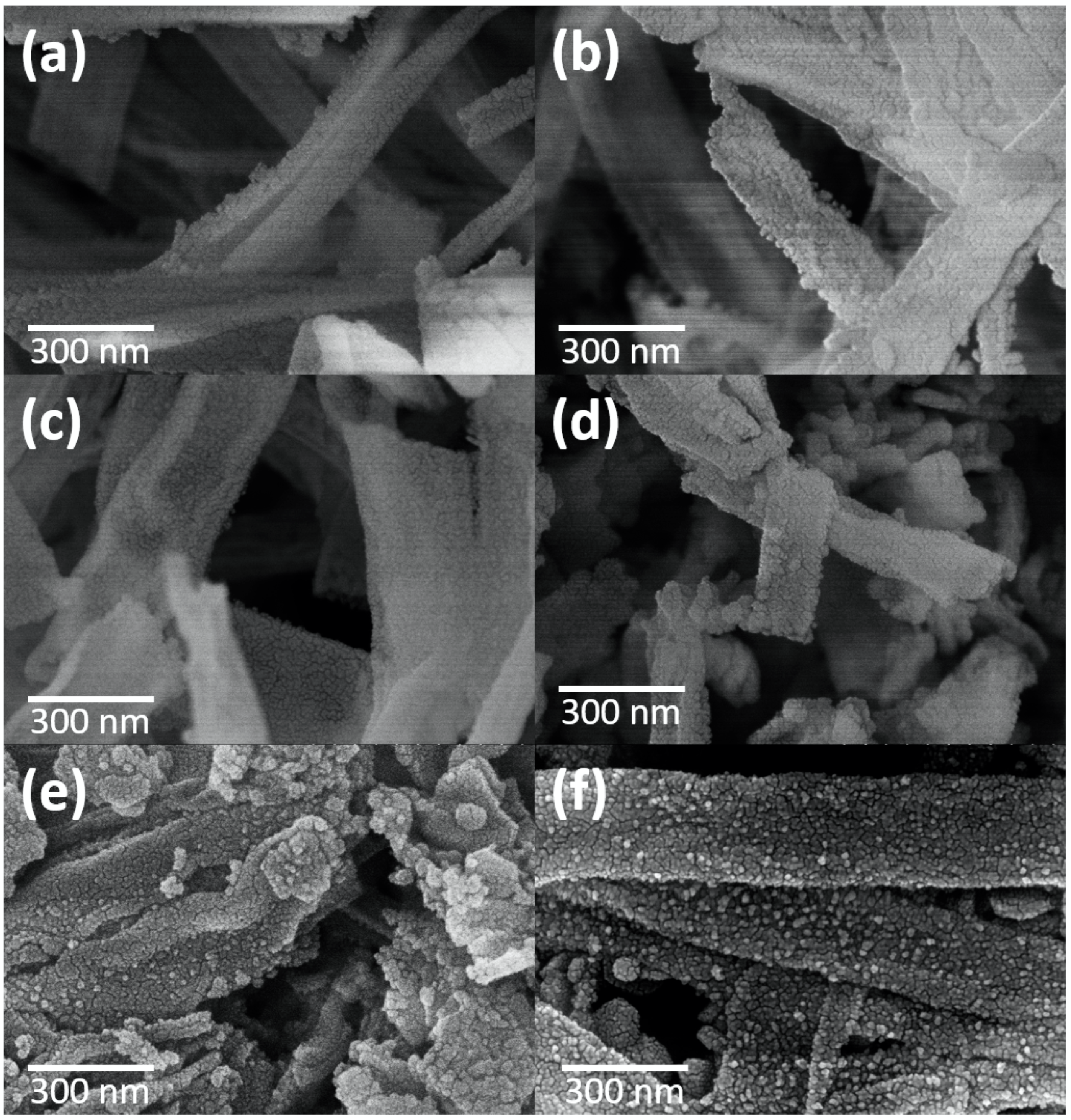

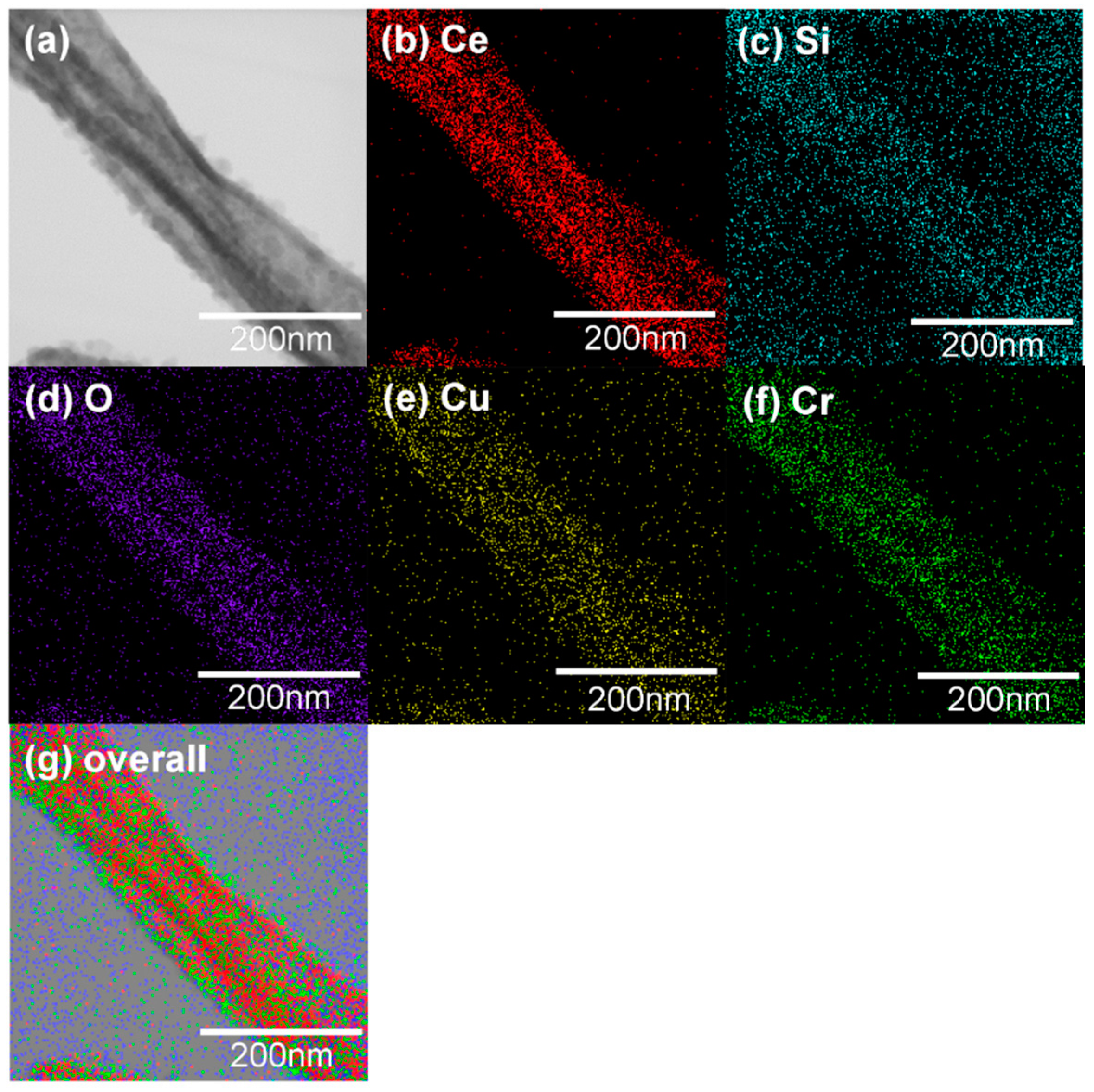
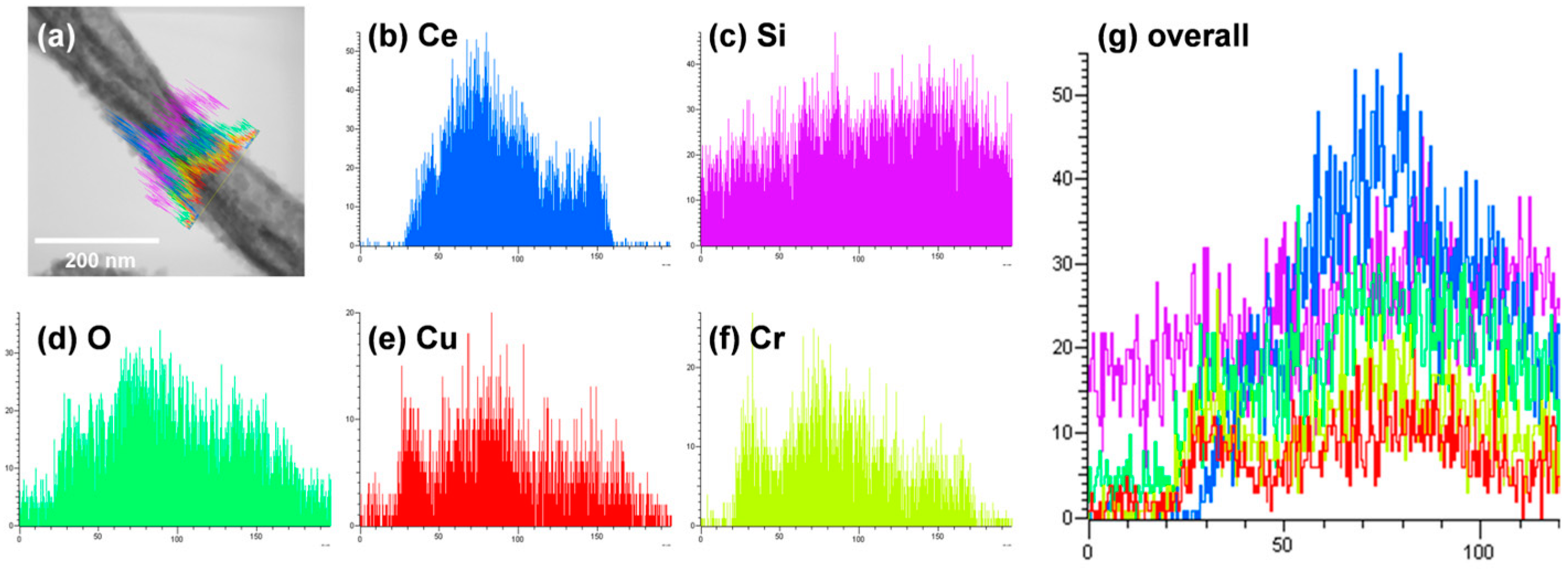
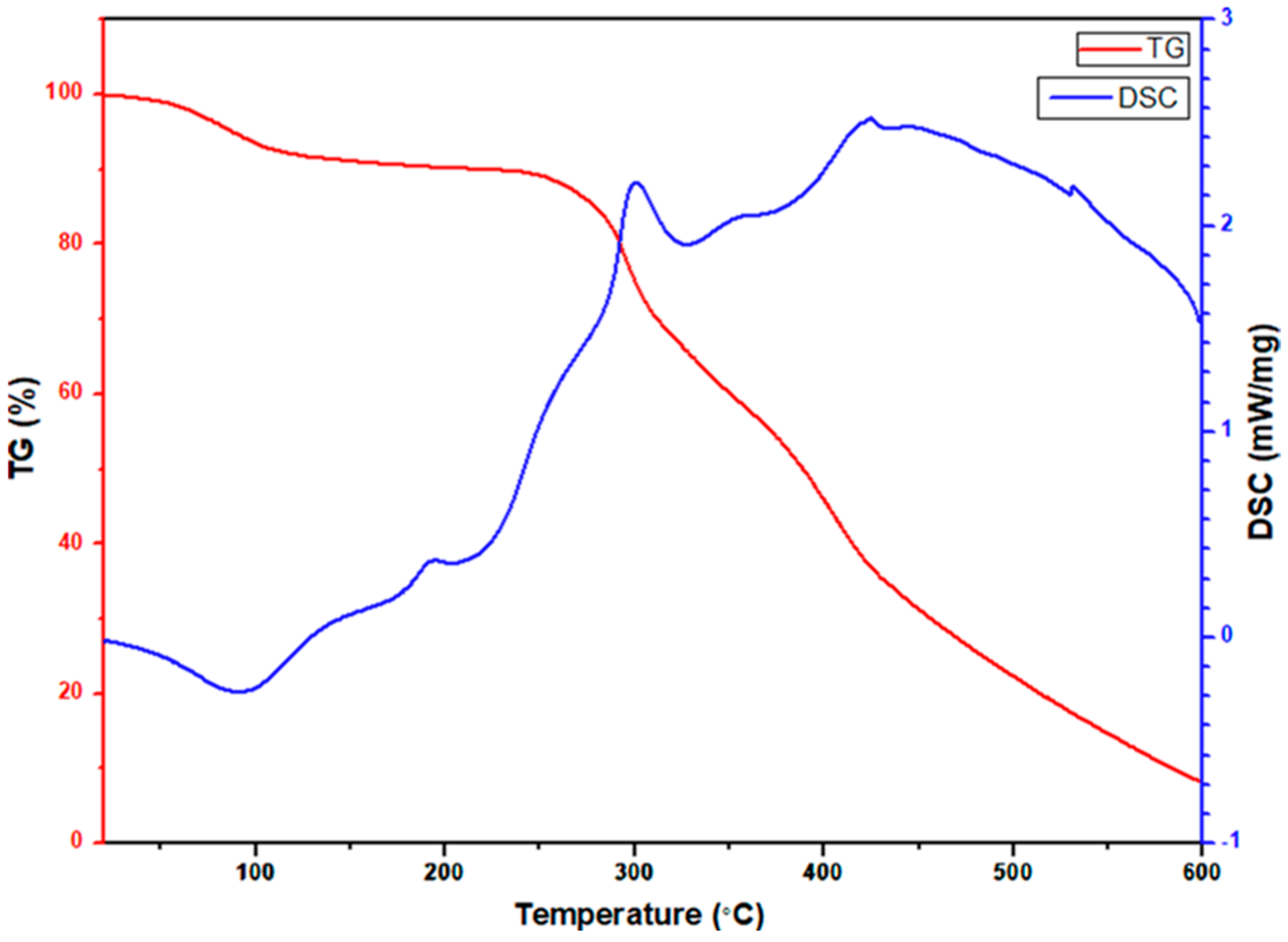

| Processes | Specific Surface Area (m2/g) | Reference |
|---|---|---|
| GNP method (CuFeO2) | 11.38 | [16] |
| Solid-state (CuCrO2) | 1.94 | [17] |
| Solid-state (CuFeO2) | 0.57 | [17] |
| Electrospinning (CuCrO2) | 7.85 | [18] |
| Electrospinning (CuFeO2) | 4.33 | [19] |
| Electrospinning (CeO2-CuCrO2) | 15.06 | This study |
| Temperature (Kelvin) | H2 Production Rate (mL min−1 g-cat−1) |
|---|---|
| 523 | 410.66 |
| 573 | 438.48 |
| 623 | 451.52 |
| 673 | 474.30 |
| 723 | 798.28 |
| 773 | 1335.16 |
Publisher’s Note: MDPI stays neutral with regard to jurisdictional claims in published maps and institutional affiliations. |
© 2022 by the authors. Licensee MDPI, Basel, Switzerland. This article is an open access article distributed under the terms and conditions of the Creative Commons Attribution (CC BY) license (https://creativecommons.org/licenses/by/4.0/).
Share and Cite
Hsu, K.-C.; Yu, C.-L.; Lei, H.-J.; Sakthinathan, S.; Chen, P.-C.; Lin, C.-C.; Chiu, T.-W.; Nagaraj, K.; Fan, L.; Lee, Y.-H. Modification of Electrospun CeO2 Nanofibers with CuCrO2 Particles Applied to Hydrogen Harvest from Steam Reforming of Methanol. Materials 2022, 15, 8770. https://doi.org/10.3390/ma15248770
Hsu K-C, Yu C-L, Lei H-J, Sakthinathan S, Chen P-C, Lin C-C, Chiu T-W, Nagaraj K, Fan L, Lee Y-H. Modification of Electrospun CeO2 Nanofibers with CuCrO2 Particles Applied to Hydrogen Harvest from Steam Reforming of Methanol. Materials. 2022; 15(24):8770. https://doi.org/10.3390/ma15248770
Chicago/Turabian StyleHsu, Kai-Chun, Chung-Lun Yu, Heng-Jyun Lei, Subramanian Sakthinathan, Po-Chou Chen, Chia-Cheng Lin, Te-Wei Chiu, Karuppiah Nagaraj, Liangdong Fan, and Yi-Hsuan Lee. 2022. "Modification of Electrospun CeO2 Nanofibers with CuCrO2 Particles Applied to Hydrogen Harvest from Steam Reforming of Methanol" Materials 15, no. 24: 8770. https://doi.org/10.3390/ma15248770








